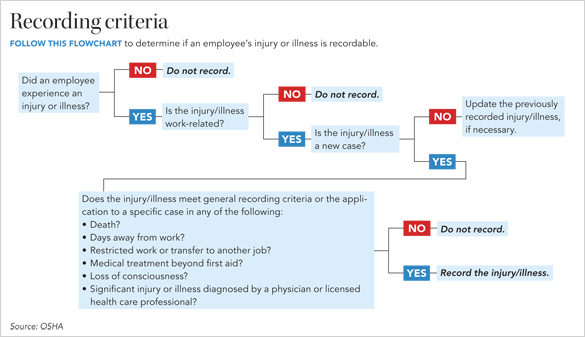For the record
Breaking down OSHA’s recordkeeping requirements

In addition to recording, some injuries or illnesses must be directly reported – either orally or in person – to OSHA within eight hours of the incident, including deaths or hospitalizations of three or more employees. This requirement extends to all employers covered by OSHA, even those in industries normally exempt from keeping records or those with fewer than 10 employees.
Employers should report any such incidents to OSHA at (800) 321-OSHA.
Privacy
Current and former employees and authorized employee representatives can gain access to an employer’s 300 log, making privacy an issue. Although an injured or ill employee’s name will appear on the log in most cases, certain situations arise in which employers should leave the name off. “You must use discretion to conceal the identity of the worker,” Taylor said.
According to OSHA, an employee’s name should not be listed on the log in the following circumstances:
- Injury and illness to intimate body parts
- Injury or illness due to a sexual assault
- Mental illness
- Infection of HIV, hepatitis or tuberculosis
- Needlestick injuries or cuts from sharp objects contaminated with bodily fluid
- Any illness in which an employee requests his or her name not to be entered on the log
Any illness in which an employee requests his or her name not to be entered on the log
In lieu of listing the employee’s name, OSHA recommends entering “privacy case.” Additionally, the agency requires employers to keep a separate, confidential list of all privacy concern cases with the case numbers and employee names.

Classifying injuries and illnesses
When filling out recordkeeping forms, employers must classify each injury or illness case. Two classifications that may cause confusion are:
Days away from work – When an injury or illness leads to an employee taking time off work. OSHA has some key points about this requirement:
- The day of the injury does not count as a day away from work.
- If a physician recommends that the employee stay home from work, employers must follow that recommendation and record it as a day away, even if the employee wishes to return to work.
- The employer must count all calendar days the employee is unable to work, regardless of whether the employee was scheduled to work on those days.
- When the injury or illness has resulted in 180 calendar days away from work, the employer should stop counting.
- An employee’s injury that carries over from one year to the next should be recorded in the year the injury occurred. If the employee is still out of work by Feb. 1 – when the injury and illness summary is required to be posted – OSHA said employers may either list the number of days the employee has been out or estimate the number of days the employee is expected to be out. The log entry should be updated when the total number of days is known or the 180-day cap is reached.
Job restriction or transfer – When an injury or illness leads to either a doctor recommending or an employer choosing to keep an employee from performing one or more routine job functions, or the employee does not work a full day.
This rule applies regardless of what work the employee chooses to do or is capable of doing. For example, if a doctor orders a worker to be on light duty but the worker still is able to fulfill all of his or her job obligations and routine functions, OSHA considers the injury recordable as restricted duty based on the doctor’s orders. "Most employers don’t count that as a restricted duty case, but by law it is," Stanley said.
The other two classifications are workplace death and “other recordable cases,” which are injuries or illnesses that do not fall under the Days Away, Restrictions and Transfers category but still must be recorded (see "Recording criteria" flowchart, above).
Common mistakes
Underreporting
Taylor called underreporting the most common mistake employers make, and offered several reasons why it may
occur:
- Poor training or lack of knowledge.
- Management may pressure employees not to record injuries and illnesses to achieve lower rates.
- Doctors may lack full knowledge of recording criteria. For example, a doctor may determine that a worker’s torn ligament, which occurred while walking down the hall, is not work-related; however, certain circumstances could make the injury recordable.
300A placement
The summary form must be placed in an area where workers are likely to see it; employers cannot hide it, block
it with other notices or hang it in a location some employees cannot access.
“Sometimes I’ll see one where it’s posted in the nurse’s office. Well, all employees don’t go to the nurse’s office. You want to make sure it’s where employees can see it, like by the time clock,” Taylor said.
Prescriptions
If a doctor writes a prescription for an injured employee, it does not matter if the employee ever picks up the
medication or uses it – the prescription pushes the medical treatment beyond first aid, according to Stanley.
"That is a recordable case, even though you’ve never used [the medication], because the doctor prescribed it," he said.
Additional resources
OSHA maintains a website on recordkeeping that covers the agency’s requirements and exceptions to the rules in greater detail.
Post a comment to this article
Safety+Health welcomes comments that promote respectful dialogue. Please stay on topic. Comments that contain personal attacks, profanity or abusive language – or those aggressively promoting products or services – will be removed. We reserve the right to determine which comments violate our comment policy. (Anonymous comments are welcome; merely skip the “name” field in the comment box. An email address is required but will not be included with your comment.)

